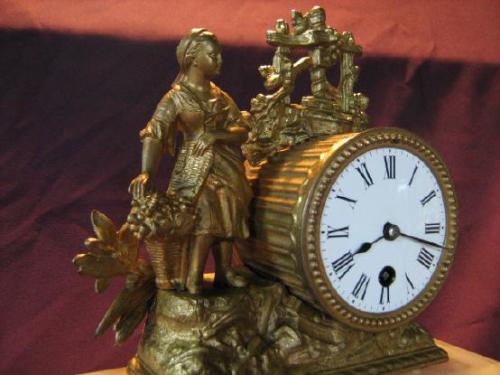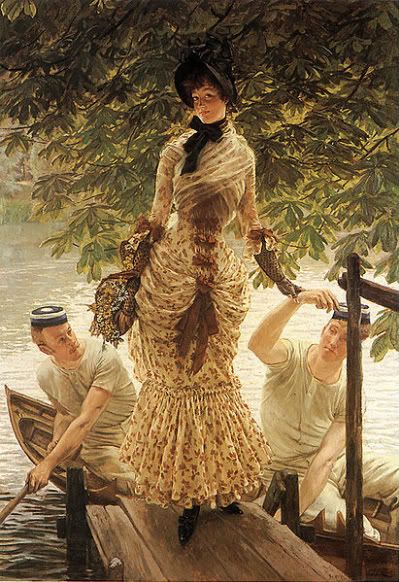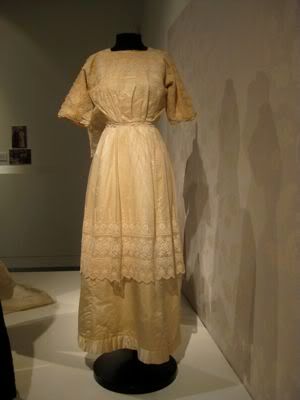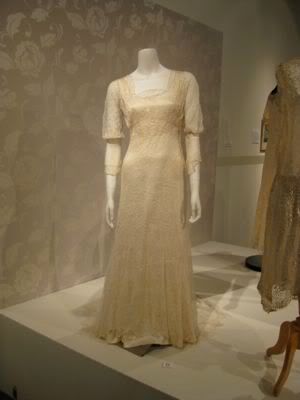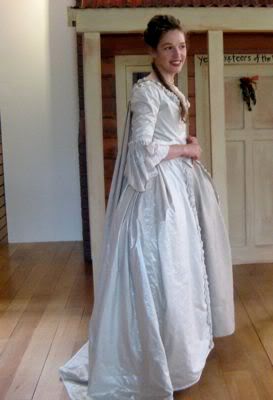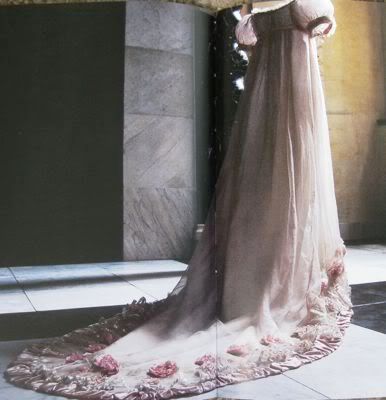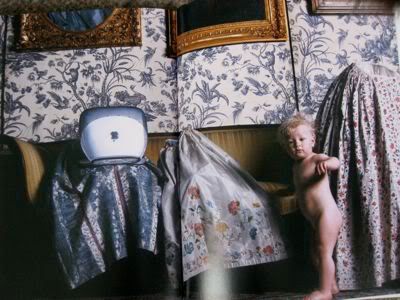Thursday, December 31, 2009
Getting Ready for the Midnight Ball
Labels:
LOOKS AND STYLE
Tuesday, December 29, 2009
Miss jumbo beauty contest 2009
Miss "Fat and Beautiful" 2009
Beersheba, Israel recently held its annual "Fat and Beautiful" beauty pageant with plus-size contestants coming from all over the country to compete in casual wear and evening gowns...but there was no swimsuit competition. Ladies had to be at least 176 lbs to enter.
Twenty-two-year old Moran Baranes, weighing in at 205 pounds, was crowned the winner. She works as a security guard and enjoys painting and dancing.













Labels:
BEAUTY
Friday, December 25, 2009
Friday Review*: I Do: 100 Years of Wedding Dresses
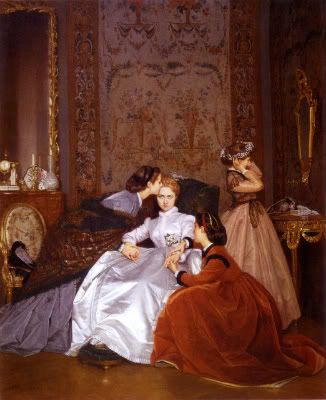
I don't have images, so enjoy Toulmouche's The Reluctant Bride, who looks more like the 'Seriously pissed off Bridezilla' to me
What it is:
An exhibition of wedding dresses at Expressions, Upper Hutt's Arts and Entertainment Centre, with dresses spanning the period from 1875 - 2006.
Remember how I spent a lovely day a few months ago looking at wedding dresses? Well, these are them, and now you can see them yourself (as long as you are in the Wellington region).
The Good:
It's an exhibition about wedding dresses? What could not be good?
Beyond the instant appeal of the topic, the exhibition is beautifully designed and curated.
The selection of dresses is inspired, reflecting both the most popular and common dress trends of each era, and a few brides who broke with the trends and chose very unique and individual dresses.
The visual design is lovely: dresses are grouped by period, with each having enough space to stand alone, without feeling isolated. A few special dresses stand on individual plinths, allowing the visitor to see them from all angles, and keeping them from competing with the other dresses.
The centre of the room is occupied by the most extravagant and over the top dress in the exhibition: a 'princess bride on acid' confection of gold silk, gold lace, embroidery, applique, lacing, ribbons, bows and matching accessories which could have overwhelmed the exhibition, but is carefully placed to complement rather than swamp the other dresses.
The whole room is tied together with panels of romantic floral wallpaper and ribbons of plain wallpaper, presenting the entire exhibition as a present to be slowly opened.
The Bad:
The bad is that I don't have photographs (yet), but you can see a lovely article with a photograph here and TVNZ did a little short on it with three gorgeous dresses in their Breakfast programme.
(You just have to get through 2 minutes and 20 seconds of randomness involving a 6 foot tall texting rabbit first, and restrain yourself from trying to reach through the screen and give the newsreader a smack when she grabs one of the dresses.)
The Ugly:
Some of the dresses aren't quite to everyone's taste.
But that is good too, because there is something to appeal to everyone, from the minimalist to the maximalist, from the traditionalist to the uber avante-garde.
(oh, c'mon, you didn't actually think I was going to say "Well, this one dress with the green bows is just beyond hideous", did you?)
The so good it is bad:
Do I need to say? With all those gorgeous dresses I want to get married again! (to the same person of course). And everyone who attends is going to go slightly dewey-eyed and wedding mad for a little bit.
The other so good is that there are going to be floor talks on Sunday the 13th from 2-3 and Thursday the 17th December from 10.30-11.30 by a local costume historian, and I hear they are going to be very good (I hope!). Maybe I'll see you there?
Labels:
DRESSES AND CLOTHING
Rate the dress: Tissot's 'On the Thames'
This week we move away from pastoral simplicity to pastoral over-the-top-ness.
Tissot is famous for his portrayals of women in decadently feminine confections. Is this model in her 1874 bustle dress, with pannier affect and shortened hemline, fichu, bonnet, and lace mittens, just a little too coy and overdone for a boating trip, or the picture of sartorial elegance for a day on the Thames?
Rate the dress on a scale of 1-10 (and of course, comments, criticisms, and socio-economic gender analysis always welcome!)
Tissot is famous for his portrayals of women in decadently feminine confections. Is this model in her 1874 bustle dress, with pannier affect and shortened hemline, fichu, bonnet, and lace mittens, just a little too coy and overdone for a boating trip, or the picture of sartorial elegance for a day on the Thames?
Rate the dress on a scale of 1-10 (and of course, comments, criticisms, and socio-economic gender analysis always welcome!)
Labels:
DRESSES AND CLOTHING
Rate the dress - Chanel circa 1927
Oh the controversy over last weeks dress!
The mixed ratings earned the dress a 6.7 out of 10.
I personally find the dress interesting just for the challenge of attempting to recreate it as an attractive garment, and I'm far from the only one with a desire to make that dress!
This week we leave impractical and constricting garments aside and look at the designer credited with discarding Victorian frou-frous, a designer noted for her clean, simple designs.
Do we like clean and simple? Do we even agree that this is clean and simple? Or is this Chanel dress a little too detailed to count as 'clean and simple', and a little too demanding for any but the best figure to carry off.

Some of you loved it, some of you hated it, and some of you were just confused and thought that Tissot might have accidentally painted the front view of the bodice and the back view of the skirt.
I personally find the dress interesting just for the challenge of attempting to recreate it as an attractive garment, and I'm far from the only one with a desire to make that dress!
This week we leave impractical and constricting garments aside and look at the designer credited with discarding Victorian frou-frous, a designer noted for her clean, simple designs.
Do we like clean and simple? Do we even agree that this is clean and simple? Or is this Chanel dress a little too detailed to count as 'clean and simple', and a little too demanding for any but the best figure to carry off.

Labels:
DRESSES AND CLOTHING
Pogey bait: costume porn
Yesterday I finally had the opportunity to take photographs of all the amazing dresses on display in Expressions.

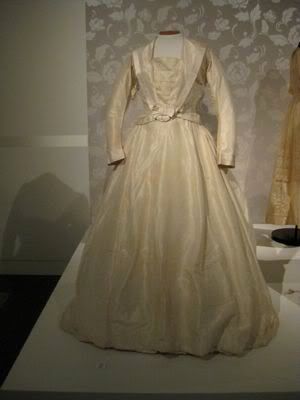
The oldest dress in the exhibition. This dress was first made in at least 1874 (and possibly even earlier than that), and was altered for another bride in 1910. It has been worn by four further brides since then - the last in 1994.
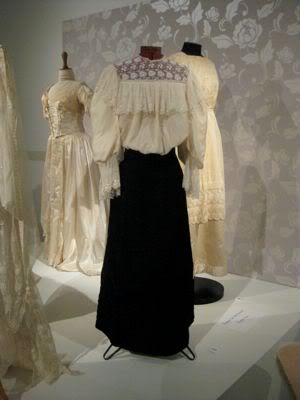
Ca. 1903 Isn't the blouse darling? The bride wore the blouse with a long white skirt for her wedding, and had the black skirt made for best wear. The details on the black skirt are amazing - I'll have to get more images of it.

ca. 1925 Images just can't capture how beautiful this dress is. It's so flowy and romantic - with tassels at the ends of the sleeves and the train.
So if you aren't in NZ - now you know what you are missing. If you are - now you know where to go for utter gorgeousness!


The oldest dress in the exhibition. This dress was first made in at least 1874 (and possibly even earlier than that), and was altered for another bride in 1910. It has been worn by four further brides since then - the last in 1994.

Ca. 1903 Isn't the blouse darling? The bride wore the blouse with a long white skirt for her wedding, and had the black skirt made for best wear. The details on the black skirt are amazing - I'll have to get more images of it.

ca. 1925 Images just can't capture how beautiful this dress is. It's so flowy and romantic - with tassels at the ends of the sleeves and the train.
ca 1937. A hailstone muslin depression era dress. Isn't it just the sweetest thing? The bride wore the little lace mitts that are on the mannequin too.
Labels:
DRESSES AND CLOTHING
The robe in progress
Lady Anne Darcy's wedding dress is turning into a long work in progress. It's wearable, but I'm still adding trim to it.
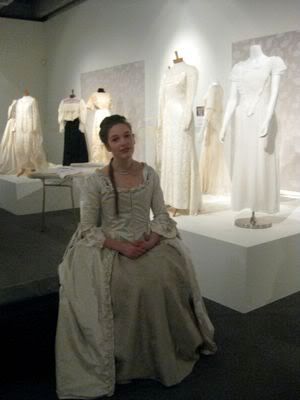
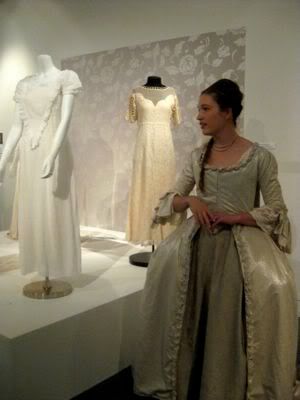
I'm adding the trim in stages, and at each stage, I'm ending up wearing the dress. It's quite fun, and feels quite historical (you never wear the same dress twice if you are constantly altering it!).
Last Sunday I wore it to the talk at Expressions with the minimal trim: little tiny puffs up and down the skirt fronts, and around the neckline:


I love the dress in side profile. It makes me look a little squat from straight forward or backwards. I'm really loving the look of the stomacher-less style that I decided to go with.

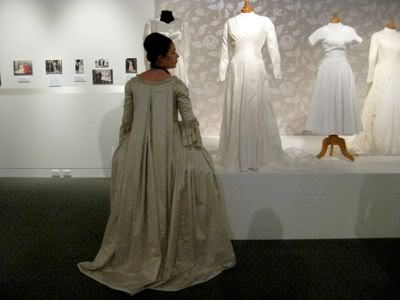
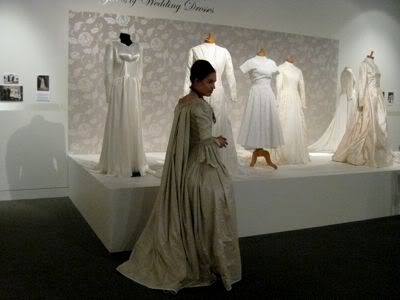



Coming on Saturday: images of me in the next incarnation of the dress, with big puffs going up the skirt.
Later there will be a metal lace stomacher that pins over the front of the dress (much later!), and sometime in the near-ish future their will be a matching jupe, rather than my faux-quilted jupe.
Labels:
DRESSES AND CLOTHING
Friday Review: Aristocratic Attire
What it is:
The Rijksmuseum publication on the collections of the wealthy Six family of Amsterdam

The Good:
To-die-for, drool worthy garments with great dating and provenance. It isn't often that you get to see an almost pristine 1759 wedding dress, or even an 1812 wedding dress, especially where the bride's names and history are known.
The really odd, what in the Buggrit Millennium Hand and Shrimp Blazes is going on here?
There are random unclothed people in all (OK, most) of the images. Yes, you read that right. Beautiful historic costumes and people in the altogether. Not even attractive clothes-less people: ordinary wrinkled undressed people.
Don't believe me?
Well: here you go:


And when there aren't sky-cladders, there are unattractive dogs, or laptops.

I really hope that images is photoshopped and the dog and costume were never in the same proximity!
The worst part is, there is no indication why anyone thought it was a good idea to have au natural models* interacting with the costumes. What does it mean? I suppose it is ummm…memorable. You aren't likely to forget the dress that was framed by wrinkled old bums.

The Rijksmuseum publication on the collections of the wealthy Six family of Amsterdam

The Good:
To-die-for, drool worthy garments with great dating and provenance. It isn't often that you get to see an almost pristine 1759 wedding dress, or even an 1812 wedding dress, especially where the bride's names and history are known.
1812 wedding gown
The Bad:
Either the writer just isn't a great writer, or the book has been translated into English with technically accurate but moderately obfuscating results. All of the parts are correct, but somehow the sum is hard to read and doesn't make much sense.
Also, the book is all about the Six family (who had various other last names as well), and some of the kids were named Nine. No, I'm not kidding. I'm sure these are perfectly ordinary and acceptable names in Amsterdam, but I spent some time reading bits of the book trying to figure out who the six [different] families were, and why a nine year old had a wedding dress.
To make the name confusion worse, I'm fairly certain the same people are referred to by different names throughout the book (pet names, full names, married names, initials), so I had to keep referring to the family tree, and I'm still not sure I am clear on who wore what when.
Finally, the images of the garments are too artistic. Garments from different periods are elegantly draped together, or photographed in soft focus, which is great if you want a pretty picture, but not fab for those of us who want to study the garment.

The Bad:
Either the writer just isn't a great writer, or the book has been translated into English with technically accurate but moderately obfuscating results. All of the parts are correct, but somehow the sum is hard to read and doesn't make much sense.
Also, the book is all about the Six family (who had various other last names as well), and some of the kids were named Nine. No, I'm not kidding. I'm sure these are perfectly ordinary and acceptable names in Amsterdam, but I spent some time reading bits of the book trying to figure out who the six [different] families were, and why a nine year old had a wedding dress.
To make the name confusion worse, I'm fairly certain the same people are referred to by different names throughout the book (pet names, full names, married names, initials), so I had to keep referring to the family tree, and I'm still not sure I am clear on who wore what when.
Finally, the images of the garments are too artistic. Garments from different periods are elegantly draped together, or photographed in soft focus, which is great if you want a pretty picture, but not fab for those of us who want to study the garment.

1835 wedding gown in soft focus. Grrrr....

Very artistic, but hard to tell what the rest of the dress looks like!

Very artistic, but hard to tell what the rest of the dress looks like!
The really odd, what in the Buggrit Millennium Hand and Shrimp Blazes is going on here?
There are random unclothed people in all (OK, most) of the images. Yes, you read that right. Beautiful historic costumes and people in the altogether. Not even attractive clothes-less people: ordinary wrinkled undressed people.
Don't believe me?
Well: here you go:


And when there aren't sky-cladders, there are unattractive dogs, or laptops.

I really hope that images is photoshopped and the dog and costume were never in the same proximity!
The worst part is, there is no indication why anyone thought it was a good idea to have au natural models* interacting with the costumes. What does it mean? I suppose it is ummm…memorable. You aren't likely to forget the dress that was framed by wrinkled old bums.

Labels:
DRESSES AND CLOTHING
Subscribe to:
Posts (Atom)
Search This Blog
Labels
ACNE
(5)
ART♥
(6)
BARBIE♥
(3)
BEAUTY
(18)
BEAUTY SCRETs
(20)
Blackheads
(2)
BODY CARE
(1)
CELEBRITY
(10)
Clothing
(14)
Contact Lenses
(4)
DREAMY MODEL
(8)
DRESSES AND CLOTHING
(62)
EYES
(2)
EYEWEAR
(2)
FACE CARE
(6)
FACIAL
(5)
FASHION
(63)
FONDATION♥
(1)
FOODs
(2)
FOOT
(1)
Gemstone
(17)
GEMSTONES
(29)
Girls
(1)
HAIR CARE
(7)
HAIR REMOVE
(2)
HAIR STYLE
(13)
HANDS
(5)
HERBAL
(6)
HOME MADE
(5)
Home Remedy
(4)
HONEY
(1)
JEWELRY
(47)
LIPs
(4)
LOOKS AND STYLE
(80)
Magnetic Attraction
(11)
Makeup
(12)
Mascara
(1)
MEN
(3)
MEN HAIR
(6)
MEN'S SKIN
(8)
NAIL
(3)
Neck Tie
(5)
OIL
(1)
OLD IS GOLD
(14)
PERFUME
(2)
PIMPLES
(4)
SEASON
(2)
SHOES
(9)
SKIN
(16)
SKIN CARE
(15)
TIPS♥FACTS
(2)
TOTKAY
(2)
VINTAGE♥
(25)
WATCH
(5)
WINTER♥
(3)
Wrinkle
(7)

